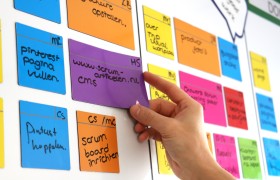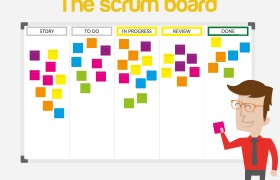
Working Agile with Scrum
Agile working is the way to stay strong as a company nowadays. In this blog we tell you what Scrum and Agile is and how these methods can work for your company.
Times are changing in a more rapid tempo unlike ever before. To make sure that one can keep up with all the changes and be able to keep taking part in this everchanging environment and shifting trends, it’s a must for companies and employees to be agile. Me as well, as the Online Marketeer at TnP I work with Scrum. I have started seeing Scrum as a necessity since it helps me a great deal with for example giving me a better overview and perspective of the situation as well as keeping my motivation high. While the main benefit of scum is that you can spread a large product over multiple, various other tasks, the extra motivation gained from it is a great external factor. I no longer look up to the large projects in fear, but instead work towards the end goal in a step-by-step manner. Which consequently motivates and inspires!

The Scrum method
The Scrum method is used as an aiding tool in the grand scheme of Agile working. In the 80s, for the first time, was the Scrum approach regarding projects introduced by Ikujiro Nonaka and Hirotaka Takeuchi. The research went on about that projects with small (multidisciplinary) teams achieved far better results opposed to just having one team tackling a large project in its entirety. Because of the discoveries of Nonaka & Takeuchi, the tone was set and Scrum was officially launched.
Agile Scrum is a way of working in an energetic way, to not only complete the project or task ahead of you, but also making sure that you achieve the best possible solution imaginable. While at first the Scrum “Framework” was used exclusively in the software development branch, nowadays it has spread and is pretty much applicable in every branch and project. Once you start Scrumming, several new roles, ceremonies and definitions will become essential. In the following paragraph, I will go into further detail regarding this matter.
Scrum master, Product owner & Scrum team
While working with Agile Scrum you work together in a dedicated Scrum team to accomplish a mutual goal or project. On average, a Scrum team consists of approximately 5 to 9 members, each with their own specialty. The team is self-guiding and especially very enthusiastic, this is partly due to the fact that everyone can focus on what he or she does best whilst maintaining a great and vital communication line with the rest of the team. The team members will band and work together to both develop and deliver a valuable product under the guidance of the Product owner. The Product owner is the one that has the interests of the stakeholders in mind and tries to reassure them of what is going on as well as making sure that the product which the Scrum team is developing, is of value. Furthermore, the Product owner will be the one keeping track of the list of user-stories, as well as the Product Backlog. A User story is a description of a piece of the product, described by the end-user. The Product owner decides which user-stories are to be prioritized. The reason behind why the Product owner is tasked with this, is because he or she is aware of the trends and developments of the market and the wishes of the end-user. As you can see, the Product owner also has a key-role in the Scrum team just like everyone else, making sure everyone matters and nobody feels left out.
We are assuming here that Scrum is used in a real scrum-team, which it normally is, it can however also be used individually and be a great aid for you when working on a more personal or specific project. It then goes without saying that there is no need for an extra Scrum Master or Product owner, because you will fill that role yourself.

Working Agile with the Scrum project approach
Before starting with Scrum, the ‘Definition of Done’ will be set up, which will decide when a user-story is to be finished. The ‘Definition of Done’ can be seen as a check-list, indicating what requirements the delivered product should meet. This checklist is indispensable to the Scrum method.
Another essential role in the Scrum approach is the Scrum Master. The Scrum Master is the one that keeps an eye on the process, making sure everything goes according to plan and thus maximizing the success that the Scrum team can achieve. Just like mentioned before, a Scrum Master is always necessary unless you work by yourself on an individual project. Since in that case you will fill that role yourself.
When dealing with Agile Scrum there are a couple of definitions that should be clear, these are necessary to know to make sure everything is implemented accordingly. With Scrum, you work in short sprints, the items of the Sprint are visualized in the Backlog and are taken care of over time. Each Sprint usually takes up 1 to 3 weeks and after that Scrum Sprint you can always present an appropriate, valuable product. The Sprint Backlog is an overview of all the activities that the Scrum team is supposed to be doing and complete during the Scrum Sprint. The input for the Sprint Backlog comes from the Product Backlog. The Product Backlog is the entire wish-list from the end-user and stakeholders. The Impediment Backlog speaks for itself, all hindrances and such are detailed and visualized here. Then there is the Burn Down Chart as well, this list shows the progress of the Scrum Sprint and what has already been realized. Also, when you are Scrumming by yourself, it is just as important to work with a Product Backlog, Impediment Backlog, Sprint Backlog etc. to keep yourself busy and encourage productivity. Continues evaluation and improvement are just as important when working with Scrum by yourself, just as much as when working in a Scrum team. What could be done better, more effective? What is this hindrance? What and how can I change to resolve this and improve?
During the Scrum project approach, the Scrum team is also responsible to attend daily meetings in which the things that are supposed to be done are discussed, as well as what is on the planning today and if there are any obstacles for the other team members.

Using a Scrum whiteboard is an absolute must when you are starting with Scrum.
Download the illustration 'What does a scrum board look like'?Agile working in an everchanging world
After reading this article you have learned more about the basics of Agile Scrum. You now also know that Scrum isn’t only applicable in a group, but can be done solo as well. Scrum also makes it possible for you to:
- Deliver a working product in a short period of time;
- Not only receive and give feedback at the end of the project, but being able to do this continuously throughout the course of the project;
- Work on your project in a flexible and energetic way to make sure that you can be at your best and overcome any possible obstacles.
Scrum has become a necessity and the power of Scrum is unprecedented to me, that I can deliver a piece of the puzzle everyday so that I can make a difference the following day is wonderful. Is Scrum something for your organisation?
Good luck!
